
Jin-ci (晋祠) Ancestral Temple Complex was first established during Northern Wei period (北魏 386-533BC) in memory of Prince Shu-Yu (叔虞), the second son of Emperor Zhou-Wuwang (周武王). During 11th to 8th century BC, Shu-Yu was bestowed by his brother Emperor Zhou-Chengwang (周成王) to control the state of Tang, a place where he devoted all his energy to improve and make it prosperous continuously for 800 years. In order to honor the achievement of this intelligent and great leader, his descendants built nine temples for him after he demised. Jin-Ci is one of China's largest Temple Garden to be named in honor of a state ruler.


The complex had gone through more than 2000 years of history with extension, renovation and restoration in various dynasties commencing from Northern Qi (550-557) to Sui, Tang, Five-Dynasty, Song, Jin, Yuan, Ming, Qing to 20th century. Its most prosperous period was within 7th to 12th century in the era of Tang and Song Dynasty. Jin-Ci has become a representative symbol of ancient garden and wood carving arts.


Many visitors are enthralled with its awesome architecture and carvings.



The beauty of Jin-ci is it completely reserved the characteristic and appearance of an ancient architecture without adding any modern factor. It is one of the best preserved heritage in China.
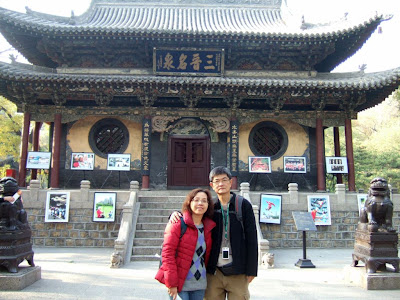

The mirror terrace was a stage for performing opera in tradition festivals. The structure was constructed as an independent building but in a combination form of a terrace, pavilion and a palace.



Building materials of Mirror Terrace were basically wood and every part of its columns and beams were skillfully carved with beautiful designs in colors.



The excessive carvings at pillars, columns and cross beams of Mirror Terrace though had been restored, they were still extra-ordinary.


Those colorful carved roof eaves are amazing.



The babbling stream that runs through the Temple Garden, is carrying with it the never aging spring water.


A scenic sight and a relaxing moment for us!


A stream of spring water!



I was crossing the Meeting Angels Bridge (Hui-Xian-Qiao 会仙桥) to see whether I have luck to say hello to angels.



The Iron Men Terrace (金人台) has 4 iron men standing at 4 corners, in which one was destroyed in war and re-cast in year 1913. The other three were all remained from Song Dynasty (960-1279). The one standing at south west was especially outstanding. These iron water guardians were master piece from the high development of iron casting technology in Song Dynasty




Dui-Yue Archway (对越) which was built in year 1576 during Ming Dynasty was behind The Terrace of Iron Men.



The two Chinese character Dui-Yue (对越) was abstracted from an ancient poetry volume (诗经), which means to appreciate and praise for the great love of mothers. Right here, mothers love was in reference to the merit and virtue of the holy mother (圣母).



The Drum Tower(鼓楼)。



The Bell Tower (钟楼)。




One of the ancestral temples (祠堂)in the garden.
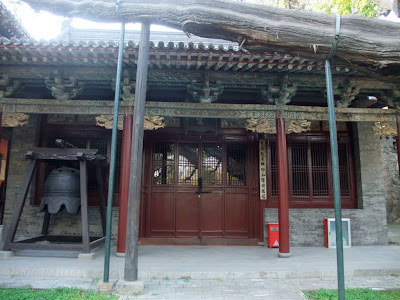

Zhou Cypress (周柏) was said to be planted 3000 years ago during Western Zhou period (1027-771BC). Originally there were two trees like a couple standing beside the Saint Mother Hall. People named them as Wind Cypress (风柏) and Dragon Cypress (龙柏) respectively. It was said that after somebody chopped off Wind Cypress, Dragon Cypress was too sad that he fell over towards Wind Cypress direction and when he was about to fall over the Saint Mother Hall, there was a new grown up cypress hold it up exactly avoiding him to fell off. People said that it was as if a son supporting a family and his father after the mother passed away.



Zhou Cypress (周柏) standing in the garden just besides Saint Mother's Hall, is the first wonder in Jin-ci garden.




The fabulous roof of Saint Mother Hall (圣母殿) and The Offering Hall (献殿).


The exquisitely wrought Offering Hall (献殿) where offerings were made to Holy Mother, was one of the three nationally treasured architectures in Jin-Ci Temple site. It was first built during Jin Dynasty in year 1168 and rebuilt in 1594. The last restoration was done in 1955. It was believed that there was some magic power if making offering to Holy Mother.



Flying Bridge over the fish pond (鱼沼飞梁) is also one of the three national treasured structures in Jin-Ci Temple site. It was built in the same time as The Saint Mother Hall in Song Dynasty to connect Saint Mother Hall to The Offering Hall on the opposite side. The Bridge is the only one of its kind that exists now. It plays an important role in the research of the ancient bridges in China.



The amazing Flying Bridge over the fish pond (鱼沼飞梁) is considered best preserved and oldest standing crossing Bridge in China. The Bridge appears in a shape of a cross with stone rails surrounded. It was supported by 34 octagon stone pillars with a lotus flower shaped base erected under the water. On top of the pillars are wooden joints. The wisdom and skill of Jin ancient people are incredible.



Panoramic view of Saint Mother Hall (圣母殿) and The Flying Bridge (鱼沼飞梁).

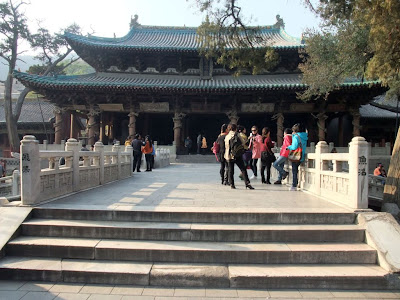

Saint Mother Hall (圣母殿) is the central axis of Jin-Ci Temple site. It was built in year 1032 during Northern Song Dynasty but was restored several times after that. The original architectural style and design was completely maintained and reserved during its most recent restoration in Ming Dynasty. This is one of the earliest surviving wooden building structure in China


According to records, there are about 300 tablets inscribed for Saint Mother Hall (圣母殿) with writings from Emperors, officials, poets and reputable people. The most famous stele was from the great Emperor of Tang Dynasty, Tang-Taizong (唐太宗). He wrote a long stele with 1203 characters when he revisited the place after he was an emperor. The most valuable stele was now kept in "Zhen-Guan-Baohan" Pavilion (贞观宝翰亭) and did not open for public. Baohan was the name given to Taizong's calligraphy and the period he was in throne was named as Zhen-Guan.
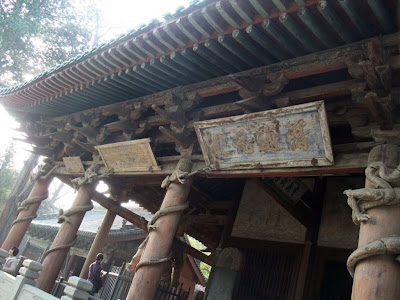

The eight coiling dragons at the pillars of Saint Mother Hall was believed to be the relics from Song Dynasty (960-1279).




The upwards curving double eaves roof of Saint Mother Hall was supported by the amazing writhing dragons that were carved out from woods and coiled around the eight front columns.



Some of its tablet relics.


A view of its internal building structure.


The building of Saint Mother Hall with double eave roof, had opened a new era of Chinese architecture.



The 300 ancient tablets with hand writing from those prominent had lined up the front corridor of Saint Mother Hall into a scenic path.

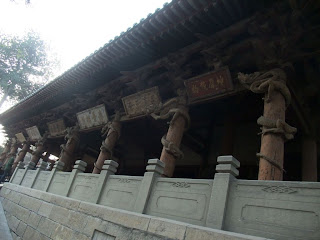

The Image of the honored matriarch enshrined in Saint Mother Hall appears in great composure and sits in a lotus position in a wooden carved altar. She was the mother of Jin's founder, Shu-Yu (叔虞) and Emperor Zhou-Chengwang (周成王), the wife of Emperor Zhou-Wuwang (周武王) and the daughter of Chinese famous general of Zhou Dynasty, Jiang-ziya (姜子牙).



There are 3 attendances standing at the right side of The Honored Matriarch, in which one was a eunuch with one ear bigger than the other and another one with eyes crossed, intently listen to his mistress, without looking directly at her. And to her left, there was a row of maidservants. The one who wore a red flower looks naturally from front look but from side, it was not the same. She looks very sad from one side and very happy from the other side. It was said that the maid was much pampered by the Matriarch and whenever she was praised she was happy but on the other hand, when thinking of being a maid to be in palace for life, she wanted to cry. It was such an incredible and amazing piece of work to sculpt out a beautiful clay figure with three vivid facial expressions when viewing from different side to highlight the poor fate of a palace maid. It was a master piece of Song color clay sculpture arts.



The 43 retinue of life-size sculptures (仕女像) including handmaidens, actresses and eunuchs, were all sculpted during Song Dynasty in a vivid and natural way, especially the 33 figures of maidservants. Each figure was unique with various pose, vivid facial expression, and in perfect proportion. They truly revealed the daily activities of a palace life in Song Dynasty. These figures were the master piece of Song Color clay sculpture arts and had special position in the sculpture arts of ancient China.



Much of the Royal Court customs and wearing attires can be clearly seen from these gorgeous painted clay figures.



The colored clay maid figures is the second wonder in Jin-Ci Temple Site.


A distance view of Saint Mother Hall.



The exquisite buildings of Saint Mother Hall and the splendid pavilions.



Many ancient trees in the temple site are over few hundred years old.

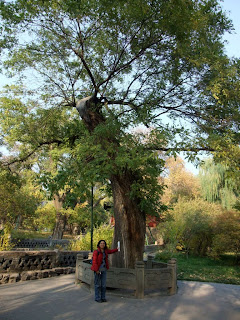


This one is 100 years old.



The Temple for The Mother of Water (水母楼) was located just on top of Never Aging Spring Pavilion. A brass image of Shui-mu gilded in gold was enshrined in the Hall. As per legend, family name of Shui-mu was Liu (柳) and she was from Jinshen Village (金胜村) nearby Jin-Ci. Liu was a very well-behaved and kind girl but after married to a family in Jin-Ci, she was treated badly by her mother-in-law. Every day she had to fetch water from long distance for her in-law who insisted to use only the front drum of water. She said the barrel carried at the back was dirty. Further the barrels were made with pointed base so that Liu was not able to rest half-way. One day, on her way back with two barrels of water on the shoulder, she met an old tired man asking from her some water for his horse. She generously offered to him but the horse was so thirsty that he finished all of her two barrels water. Liu became so worried as it was too far to go back and fetch the water again. Coming to understand her situation, the old man gifted her a golden horse whip and told her to put it in the water jug and whenever she required water just pulled out and lightly hit at the jug. Liu went home with doubt but it worked. From then, she did not need to walk far and get water from elsewhere. Her secret was later discovered by her sister-in-law. One day when she was allowed to go back home to visit her parent, her sister-in-law took her whip and hit hard to the jug. Large amount of water began to burst out and flowed over all places that it was possible to flood the village. Liu, upon hearing the incident when she was combing her hair, rushed back and without any hesitation sat on the water jug. The flow of water became small and people around were saved but Liu never could come out of jug .

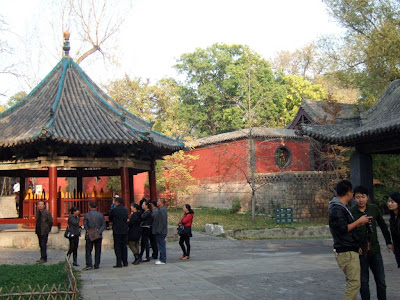

The Never Aging Spring (难老泉) is the third wonder in Jin-Ci Temple site. The Spring Pavilion was Octagon in shape with pointed roof. It was first built within year 550-559 in Northern Qi Dynasty but restored in Ming Dynasty during years 1552-1567. Nevertheless, the style of this pavilion structure that was constructed over spring water was still maintained as it was in Northern Qi.



The name of Never Aging Spring was abstracted from ancient Poem volume Shi-Jing (诗经- 永赐难老) which means never getting old is forever gifted. It was so named in Northern Qi Dynasty, was also because it continuously flows out from the well under the pavilion, day and night for 365 days, never ceased. The spring was one of the main water sources of Jin Water. Unfortunately, due to environmental purposes, it has to be supported by a pump today.



The spring water sprouting out from 5 meter underground is flowing out through the dragon mouth to the pond. Locals believe that one mouthful of the spring water or a handful of it to wash your face, will help you to keep young. Believe or not, try it!



The temperature of the spring water always maintains 17 degree C, and never freeze in severe cold weather in winter. It was said that the grass that grow under the water always remains green throughout the year.



There was a 人 shape levee at the pond with 7 water flowing holes at the north and 3 at the south. The levee was made during Song Dynasty by the State Government to solve the water rights problem between people of the north and south villages who had been fighting for long period since 453 BC when water started to channel from the spring water source to irrigate the farms. As a mediator between the two parties at that time, the Song official decided to put 10 copper coins inside a large pot of boiling oil in the pond and whatever numbers of coin the representative took out would be the number of share they received from the source of water. A young man named Zhang from Northern village immediately jump into the boiling oil and got out 7 pieces of them. The levee was made as the result and in memory of Zhang, northern villages buried him at levee border and built a water tomb stone for him.



The arrangement of buildings, trees, streams and bridges seen to embody a Zen-like mystical way.



People are not only attracted by its three wonders, The 3000 years old cypress, the colored clay maids sculpture and the never aging spring water but also are drawn to its site by its natural heritage.



No comments:
Post a Comment